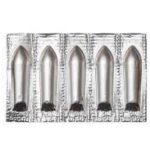When Can I Pee After Progesterone Suppository?

What is progesterone vaginal suppository?
Progesterone vaginal suppository is used to cause menstrual periods in women who have not yet reached menopause but are not having periods due to a lack of progesterone in the body. Progesterone vaginal suppository is also used in fertility treatment as part of Assisted Reproductive Technology (ART) for women unable to get pregnant due to a lack of natural progesterone in the body.
Progesterone is a female hormone important for ovulation and menstruation. Progesterone causes changes in the lining of your uterus, making it easier for a fertilized egg to attach to the uterus at the beginning of pregnancy. Progesterone then helps your body maintain the pregnancy.
Progesterone vaginal suppository is also used to prevent overgrowth in the lining of the uterus in postmenopausal women who are receiving estrogen hormone replacement therapy.
How is Progesterone vaginal suppository used?
Step 1: Wash hands with soap and water. You may choose to wear disposable gloves as well.
Step 2: Remove the outer wrapping of the progesterone vaginal suppository. To remove: pull outwards on the two flaps of the suppository to reveal the suppository.
Step 3: Place the progesterone vaginal suppository in the applicator. The use of an applicator is OPTIONAL. Place the flat end of the suppository into the top of the applicator. The pointed end of the suppository should be at the top.
When using your fingers:
- Place your fingers on the flat end of the suppository
- Insert the pointed end of the suppository into the vagina
- Find The Correct Position.
You may lay on your back with your knees bent or stand with your feet spread a few inches apart with your knees bent.
Step 4: Insert Applicator by holding the applicator from the opposite end from where the suppository is. Gently insert the applicator into the vagina as far as it will comfortably go. Push on the plunger to insert the suppository.
Step 5: Once you have placed your progesterone vaginal suppository into the vagina, you can gently remove the applicator.
Step 6: Wash your hands and the applicator once you have finished administering your progesterone vaginal suppository, wash your hands thoroughly with soap and water. Wash the applicator with soap and water as well to avoid contamination.
When should I use progesterone vaginal suppository?
Doctors recommend that you should put the suppository high in the vagina the first thing in the morning and try to stay in bed for 10-15 minutes if possible (set your alarm early!). At night, you should put the suppository high in the vagina just before you go to sleep. If you plan to have intercourse, put the suppository in afterward. However, it will not hurt you or your partner to have intercourse with the suppository in place and should not interrupt your sex life. You may find that it is more comfortable to wear a mini pad during the day when using progesterone vaginal suppositories as they will melt and create a light discharge.
When can I pee after progesterone suppository?
Doctors and health professionals advise that you wait for at least 45 minutes to 1 hour after inserting a progesterone vaginal suppository before you urinate as peeing too early may result in the medication leaking out.
Nevertheless, if you feel pressed after inserting progesterone vaginal suppository, use the bathroom immediately because holding your urine for too long can weaken the bladder muscles over time. This can lead to problems such as incontinence and not being able to fully empty your bladder. Holding your urine for extremely long periods of time can also cause urinary tract infections due to bacteria build-up.
What should I watch for while using progesterone vaginal suppository?
Visit your doctor or health care professional for regular checks on your progress. If your doctor or health care professional instructs you to use any other medicines in the vagina while you are using this medicine, you should separate the doses by at least 6 hours.
You may notice a white discharge of medicine while using this medicine. This is normal. If it becomes bothersome, contact your doctor or health care professional.
What are the side effects of progesterone vaginal suppository?
Common side effects of progesterone vaginal suppository include:
- breast tenderness,
- headache,
- weight gain or loss,
- acne,
- nausea,
- increased body or facial hair,
- loss of scalp hair,
- drowsiness, or
- dizziness.
Tell your doctor right away if you have serious side effects from progesterone injection including:
- unusual vaginal bleeding/discharge (e.g., breakthrough bleeding, spotting),
- stopped menstrual periods,
- breast lumps,
- swelling of the ankles or feet,
- mental/mood changes (e.g., depression, nervousness),
- dark patches on the skin or face,
- frequent or painful urination,
- dark urine,
- yellowing eyes or skin,
- stomach or abdominal pain, or
- persistent nausea and vomiting.
This is not a complete list of possible side effects. If you notice other effects not listed above, contact your doctor or pharmacist.
In the US –
Call your doctor for medical advice about side effects. You may report side effects to FDA at 1-800-FDA-1088 or at www.fda.gov/medwatch.
In Canada – Call your doctor for medical advice about side effects. You may report side effects to Health Canada at 1-866-234-2345.





